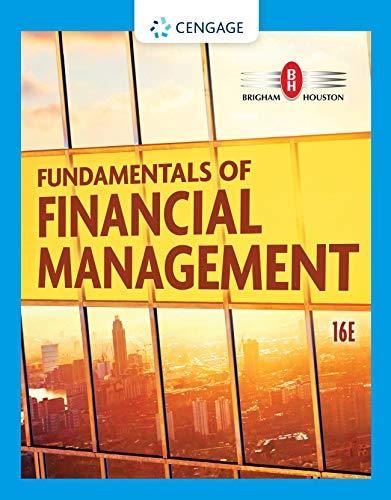Use a spreadsheet model to evaluate the project analyzed in Problem 13-8. Problem 13-8 Enterprises is considering
Question:
Use a spreadsheet model to evaluate the project analyzed in Problem 13-8.
Problem 13-8
Enterprises is considering buying a vacant lot for an after-tax cost of $1.4 million. If the property is purchased, the company’s plan is to invest another $6 million after taxes today (t = 0) to build a hotel on the property. The after-tax cash flows from the hotel will depend critically on whether the state imposes a tourism tax in this year’s legislative session. If the tax is imposed, the hotel is expected to produce after-tax cash flows of $500,000 at the end of each of the next 15 years. If the tax is not imposed, the hotel is expected to produce after-tax cash flows of $1,200,000 at the end of each of the next 15 years. The project has a 12% WACC. Assume at the outset that the company does not have the option to delay the project.
a. What is the project’s expected NPV if the tax is imposed?
b. What is the project’s expected NPV if the tax is not imposed?
c. Given that there is a 45% chance that the tax will be imposed, what is the project’s expected NPV if management proceeds with it today?
d. Although the company does not have an option to delay construction, it does have the option to abandon the project 1 year from now if the tax is imposed. If it abandons the project, it will sell the complete property 1 year from now at an expected price of $7 million after taxes. Once the project is abandoned, the company will no longer receive any cash flows. Assuming that all cash flows are discounted at 12%, will the existence of this abandonment option affect the company’s decision to proceed with the project today? Explain.
e. Finally, assume that there is no option to abandon or delay the project, but that the company has an option to purchase an adjacent property in 1 year for an after-tax investment of $1.7 million (outflow at t = 1). If the tourism tax is imposed, the expected NPV of developing this property (as of t = 1) will be only $500,000 (so it doesn’t make sense to purchase the property for $1.7 million after taxes). However, if the tax is not imposed, the expected NPV of the future opportunities from developing the property will be $5 million (as of t = 1). Thus, under this scenario, it makes sense to purchase the property for $1.7 million after taxes (at t = 1). Assume that these cash flows are discounted at 12%, and the probability that the tax will be imposed is still 45%. What is the most the company would pay today (t = 0) for the $1.7 million purchase option (at t = 1) for the adjacent property?
Step by Step Answer:

Fundamentals Of Financial Management
ISBN: 9780357517574
16th Edition
Authors: Eugene F. Brigham, Joel F. Houston





